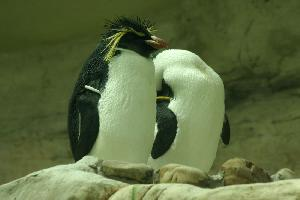
Poids et mesures
| Hauteur au garrot | 40 cm |
|---|---|
| Poids | de 1,5 à 2 kg |
| Vitesse | 6 km/h |
Description de l'animal
The Little Penguin (Eudyptula minor albosignata), also known as the White-flippered Penguin, is a captivating and diminutive species within the penguin family. This particular subspecies is distinguished by its unique physical characteristics and limited geographic distribution. Primarily found along parts of the New Zealand coastline, especially around Banks Peninsula and adjacent areas of Canterbury, it has become a subject of interest and conservation efforts due to its restricted range and the threats it faces in its natural habitat.Characterized by its small stature, the Little Penguin typically reaches about 25 to 30 centimeters in height and weighs approximately 1 to 1.5 kilograms, making it the smallest member of the penguin family. Its plumage is a striking blend of colors, with deep blue to slate-gray feathers covering the back and flippers, and a pristine white belly. The Eudyptula minor albosignata is notably marked by a more prominent white border along the leading edge of its flipper, compared to its cousins, which serves as a distinguishing feature of this subspecies.
These penguins are superb swimmers, using their flippers with remarkable efficiency to propel themselves through the water while hunting for food. Their diet primarily consists of small fish, squid, and crustaceans, which they catch with agility and precision. Little Penguins are known to dive to depths of up to 70 meters in pursuit of prey, although most of their foraging occurs at shallower depths.
Breeding season for the Little Penguin is a time of significant activity and social interaction. They are monogamous during a breeding season, with pairs often reuniting year after year to raise their offspring together. Nests are constructed in burrows dug into sand, soil, or vegetation, or in natural crevices and caves along the coastline. The female typically lays one or two eggs, which are then incubated by both parents over a period of about 35 to 36 days. The chicks are born with a downy coat, which is replaced by waterproof feathers as they mature, preparing them for life at sea.
Despite their resilience and adaptability, Little Penguins face several threats that impact their survival. Predation by introduced species such as dogs, cats, and ferrets, along with habitat destruction and pollution, poses significant risks. Moreover, their breeding sites are vulnerable to human disturbance and climate change, which can affect food availability and nesting success.
Conservation efforts are crucial to ensure the survival of the Little Penguin, particularly the Eudyptula minor albosignata subspecies. Measures such as predator control, habitat restoration, and the establishment of protected areas have been implemented to safeguard these enchanting birds and their environment. Public awareness and education play a vital role in conservation, helping to foster a deeper understanding and appreciation of the Little Penguin and the challenges it faces.
In conclusion, the Little Penguin (Eudyptula minor albosignata) is a remarkable and endearing species that captivates the hearts of those who encounter it. Its unique characteristics, combined with its vulnerability in the face of environmental threats, underscore the importance of concerted conservation efforts to ensure that future generations may continue to marvel at the beauty and resilience of these small but mighty creatures of the sea.
Animaux similaires
Nouvelles photos d'animaux
Top 10 des animaux
- Dolphin gull (Leucophaeus scoresbii)
- Diana monkey (Cercopithecus diana)
- Moustached guenon (Cercopithecus cephus)
- Galápagos tortoise (Geochelone nigra complex)
- Japanese macaque (Macaca fuscata)
- Russian tortoise (Testudo horsfieldii)
- Stone loach (Barbatula barbatula)
- Greek tortoise (Testudo graeca)
- Common flying dragon (Draco volans)
- Vendace (Coregonus albula)


